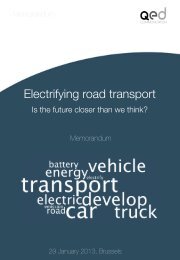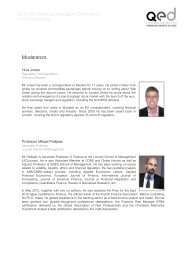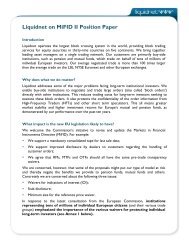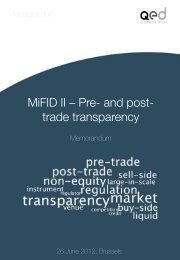FIA EPTA's position paper - Futures Industry Association
FIA EPTA's position paper - Futures Industry Association
FIA EPTA's position paper - Futures Industry Association
Create successful ePaper yourself
Turn your PDF publications into a flip-book with our unique Google optimized e-Paper software.
Since automation and “HFT” practices are likely to present the biggest change to financial markets in<br />
recent years, one should ask whether markets serve users more efficiently now than they did five or<br />
ten years ago, in order to illustrate the contribution of “HFT”.<br />
Numerous academic studies have addressed this question by examining transaction data from<br />
exchanges in North America, Europe and Asia. Virtually all of these studies have demonstrated that<br />
today‟s markets are substantially better off in any relevant metric that one chooses to focus on,<br />
including spreads, liquidity, costs, pricing efficiencies and even intraday volatility. In addition, many<br />
of these studies have presented evidence that automated trading has positively contributed to these<br />
various measures of market quality.<br />
The relevant metrics which determine market quality (and for which academic research showed a<br />
positive effect from HFT) are:<br />
Bid-ask spreads<br />
Bid-ask spreads substantially narrowed in all major markets. For example, Professors Angel, Harris<br />
and Spratt found in their 2010 study 14 that bid-ask spreads in the U.S. equities market narrowed<br />
considerably during the period 1993 to 2009. This same phenomenon has been observed in all<br />
European markets.<br />
Liquidity<br />
Due to increased competition, exchanges have invested considerable amounts in new technologies<br />
in order to increase their speed and capacity and attract HFTs which provide liquidity. For example,<br />
Professors Riordan and Storkenmairn found in their 2009 study 15 that improvements in the speed of<br />
the Xetra trading system at Deutsche Borse led to increased liquidity and improved price discovery.<br />
Pricing efficiency/price discovery<br />
Based on numerous academic studies, there is strong evidence that pricing efficiencies and price<br />
discovery have improved. 16<br />
Trading costs<br />
Trading costs have decreased considerably. The advent of “HFT” has enabled greater competition<br />
among exchanges, particularly in the equity markets. At the same time, increased automation in<br />
trading technology has enabled many institutions to access the markets through algorithms.<br />
Compared to the voice-based brokerage of ten years ago at tariffs of 25-40 basis points, institutions<br />
now access the markets through algorithms at rates as low as 1-3 basis points. Data compiled by<br />
Oxera 17 shows a decrease of 21% in trading costs between 2006 and 2009.<br />
These improved metrics positively impact on the real economy in the following ways:<br />
• Institutional investors are able to achieve better returns for those whose capital they have been<br />
entrusted with – the significant European pension funds.<br />
• Retail investors are equally able to directly benefit from lower costs of trading and improved<br />
quality of execution.<br />
• Corporate issuers can continue to grow their businesses by raising new capital in the primary<br />
market whose existence is entirely dependent on an efficient secondary market.<br />
14 Angel, James J., Harris, Lawrence and Spatt, Chester S., “Equity Trading in the 21st Century", 23 February 2010, Marshall School<br />
of Business Working Paper No. FBE 09-10 [http://<strong>paper</strong>s.ssrn.com/sol3/<strong>paper</strong>s.cfm?abstract_id=1584026]<br />
15 Riordan, Ryan and Storkenmaier, Andreas, “Latency, Liquidity and Price Discovery”, (November 22, 2011). Journal of Financial<br />
Markets, Forthcoming , [http://www.sec.gov/comments/s7-02-10/s70210-122.pdf]<br />
16 Brogaard, August 2010; Hendershott, Riordan “High Frequency Trading and Price Discovery”; Hendershott, Jones, Menkveld<br />
“Does Algorithmic Trading Improve Liquidity?” February 2011 [http://<strong>paper</strong>s.ssrn.com/sol3/<strong>paper</strong>s.cfm?abstract_id=1928510]<br />
17 Oxera<br />
8










